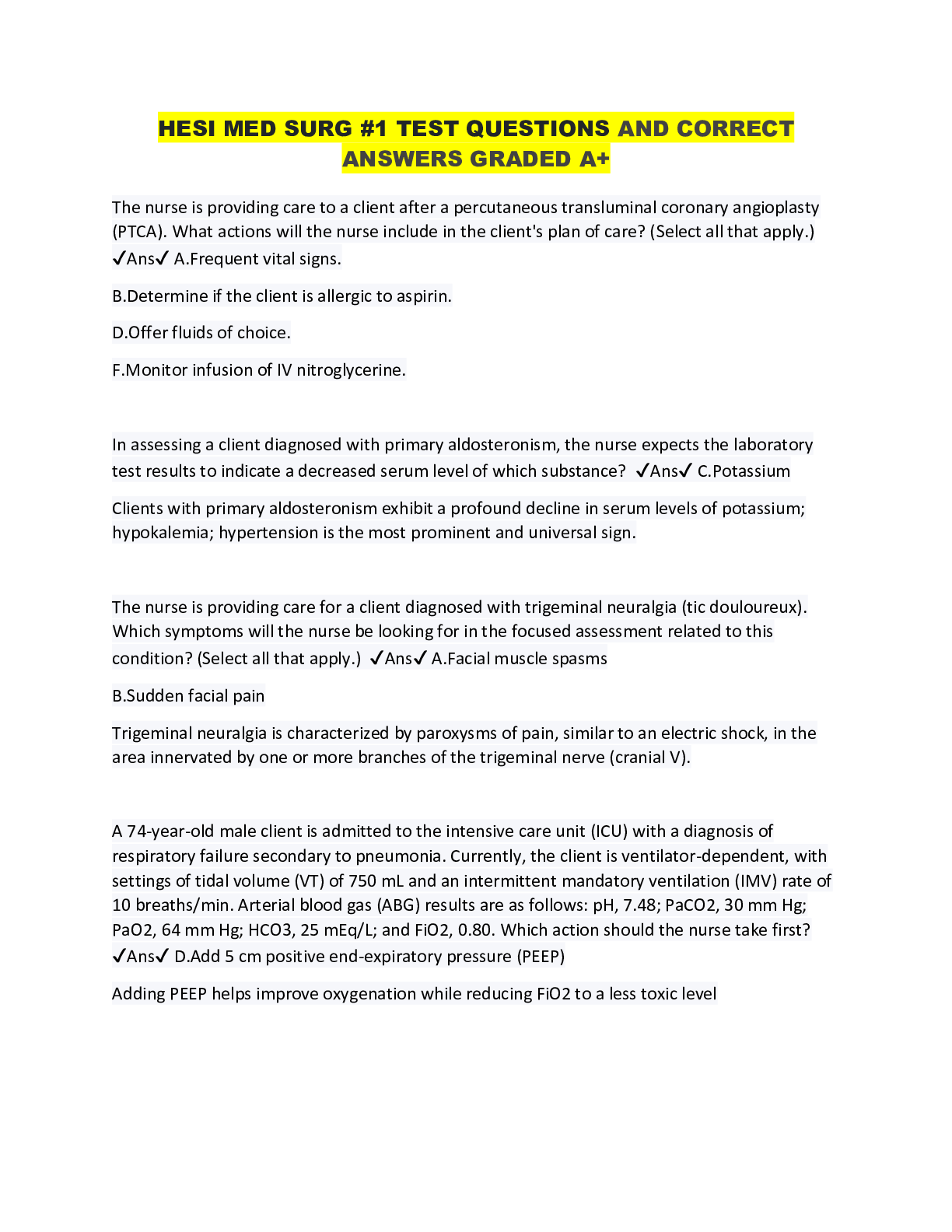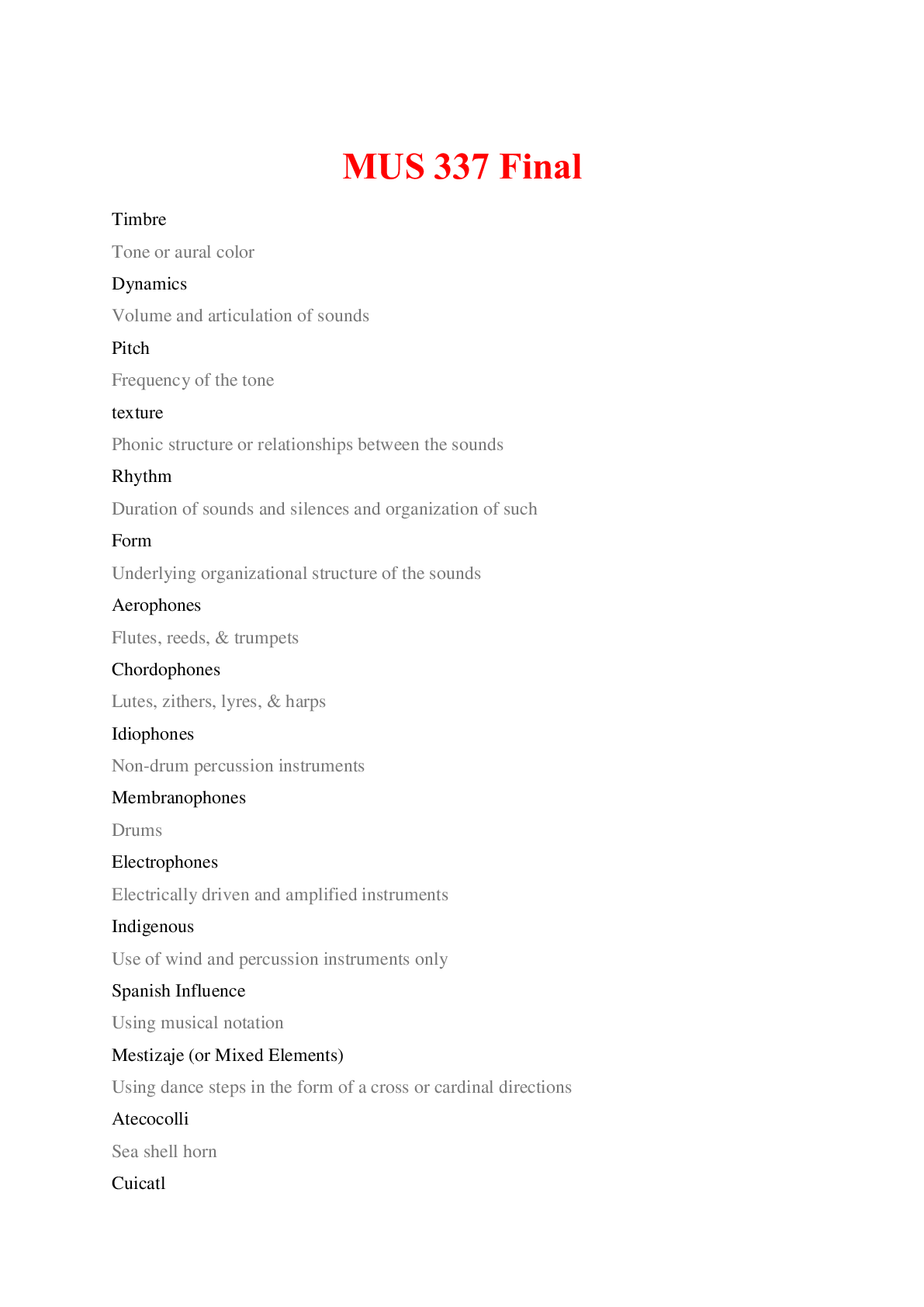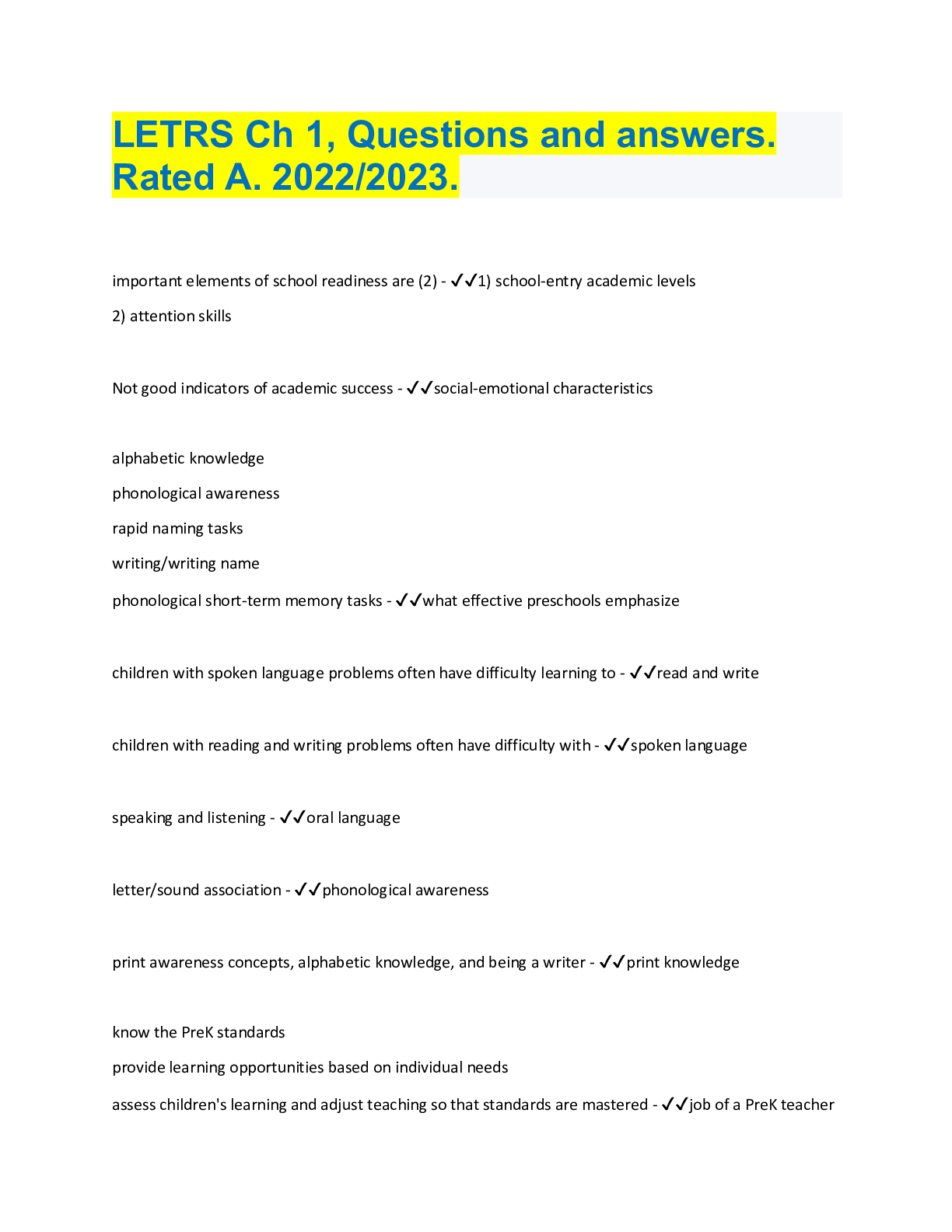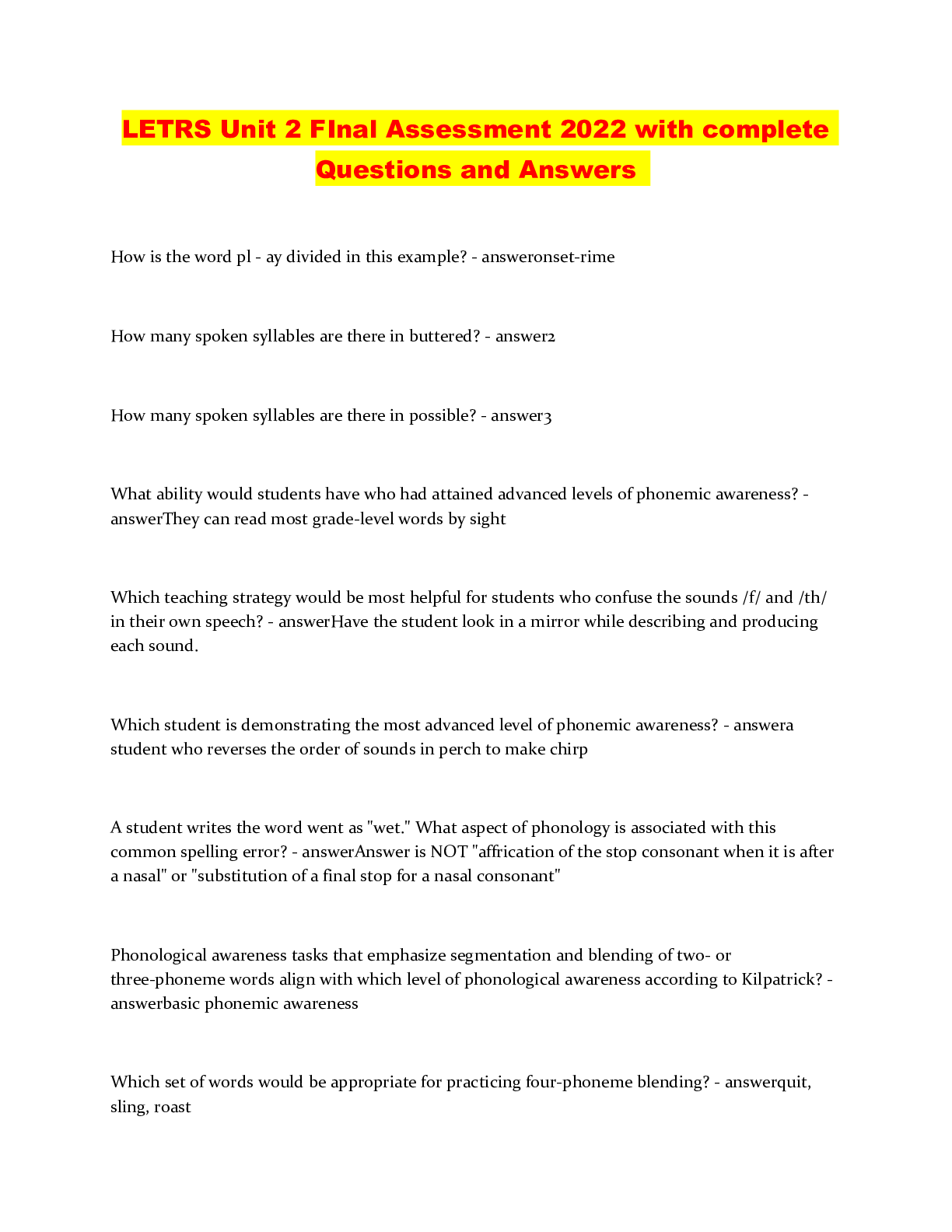Medicine > QUESTIONS & ANSWERS > HESI MED SURG #1 TEST 100% PASS (All)
HESI MED SURG #1 TEST 100% PASS
Document Content and Description Below
HESI MED SURG #1 TEST 100% PASS The nurse is providing care to a client after a percutaneous transluminal coronary angioplasty (PTCA). What actions will the nurse include in the client's plan of car... e? (Select all that apply.) ✔✔A.Frequent vital signs. B.Determine if the client is allergic to aspirin. D.Offer fluids of choice. F.Monitor infusion of IV nitroglycerine. In assessing a client diagnosed with primary aldosteronism, the nurse expects the laboratory test results to indicate a decreased serum level of which substance? ✔✔C.Potassium Clients with primary aldosteronism exhibit a profound decline in serum levels of potassium; hypokalemia; hypertension is the most prominent and universal sign. The nurse is providing care for a client diagnosed with trigeminal neuralgia (tic douloureux). Which symptoms will the nurse be looking for in the focused assessment related to this condition? (Select all that apply.) ✔✔A.Facial muscle spasms B.Sudden facial pain Trigeminal neuralgia is characterized by paroxysms of pain, similar to an electric shock, in the area innervated by one or more branches of the trigeminal nerve (cranial V). A 74-year-old male client is admitted to the intensive care unit (ICU) with a diagnosis of respiratory failure secondary to pneumonia. Currently, the client is ventilator-dependent, with settings of tidal volume (VT) of 750 mL and an intermittent mandatory ventilation (IMV) rate of 10 breaths/min. Arterial blood gas (ABG) results are as follows: pH, 7.48; PaCO2, 30 mm Hg; PaO2, 64 mm Hg; HCO3, 25 mEq/L; and FiO2, 0.80. Which action should the nurse take first? ✔✔D.Add 5 cm positive end-expiratory pressure (PEEP) Adding PEEP helps improve oxygenation while reducing FiO2 to a less toxic level The clinic nurse is providing post-operative teaching for a client scheduled for a myringoplasty. Which client statements indicate to the nurse that the teaching has been effective? (Select all that apply.) ✔✔B."I will avoid forceful and deep coughing until my post-op checkup. C."I must lay flat on my non-operative side for the first 12 hours after surgery." D."My hearing may be less or muffled until the packing comes out." The client must keep the ear bandage clean and dry until the packing is removed. Showering and hair washing is discouraged. During the shift report, the charge nurse informs a nurse of a reassignment to another unit for the day. The nurse begins to sigh deeply and tosses about her belongings when preparing to leave. What is the best immediate action for the charge nurse to take? ✔✔A. Continue with the shift report and talk to the nurse about the incident at a later time. Continuing with the shift report is the best immediate action because it allows the nurse who was floated some cooling off time. At a later time (after the nurse has cooled off) the charge nurse should discuss the conduct of the nurse in private. The nurse is completing an admission interview for a client with Parkinson disease. Which question will provide additional information about manifestations that the client is likely to experience? ✔✔C."Have you ever been frozen in one spot, unable to move?" Clients with Parkinson disease frequently experience difficulty in initiating, maintaining, and performing motor activities. They may even experience being rooted to the spot and unable to move. The nurse teaches a client with type 2 diabetes nutritional strategies to decrease obesity. Which food items chosen by the client indicate understanding of the teaching? (Select all that apply.) ✔✔B.Salmon C.Broccoli E.Banana Options B, C, and E provide fresh fruits, lean meats and fish, vegetables, whole grains, and lowfat dairy products. All are recommended by the American Diabetes Association (ADA) and are a part of the My Plate guidelines recommended by the U.S. Department of Agriculture (USDA). Which nursing action would be appropriate for a client who is newly diagnosed with Cushing syndrome? ✔✔A.Monitor blood glucose levels daily. Cushing syndrome results from a hypersecretion of glucocorticoids in the adrenal cortex. Clients with Cushing syndrome often develop diabetes mellitus. Monitoring of serum glucose levels assesses for increased blood glucose levels so that treatment can begin early A resident in a long-term care facility is diagnosed with hepatitis B. Which action should the nurse take with the staff caring for this client? ✔✔A.Determine if all employees have had the hepatitis B vaccine series. Hepatitis B vaccine should be administered to all health care providers. Hepatitis A (not hepatitis B) can be transmitted by fecal-oral contamination. A client in the emergency department is bleeding profusely from a gunshot wound to the abdomen. What action should the nurse immediately? ✔✔C.Maintain the client in a supine position to reduce diaphragmatic pressure and visualize the wound. Placing the client in a supine position reduces diaphragmatic pressure, thereby enhancing oxygenation, and allows for visualization of the abdominal wound. While at a home game, the mother of a 6-year-old is heard screaming, "My child is having an asthma attack! Can anyone help?" The nurse arrives and finds the child gasping for breath with circumoral cyanosis. What are the nurse's next actions? (Select all that apply.) ✔✔A.Yell, "Call 911." B.Ask the mother if she has the child's bronchodilator. E.Stay with the child and mother until the ambulance arrives. F.Sit the child straight up in Fowler's position. A client is diagnosed with an acute small bowel obstruction and suddenly spikes a temperature of 102°F/38.9°C. What other assessments should the nurse include in the client's focused assessment? (Select all that apply.) ✔✔A.Nausea and vomiting B.Loss of appetite C.Abdominal cramping D.Guarding with abdominal palpation The nurse is assessing a 75-year-old client for symptoms of hyperglycemia. Which symptom of hyperglycemia is an older adult most likely to exhibit? ✔✔D.Infection Signs and symptoms of hyperglycemia in older adults may include fatigue, infection, and evidence of neuropathy (e.g., sensory changes). An older client comes to the outpatient clinic complaining of left calf pain. The nurse notices a reddened area on the calf of the right leg that is warm to the touch, and the nurse suspects that the client may have thrombophlebitis. Which additional assessment is most important for the nurse to perform? ✔✔B.Auscultate the client's breath sounds. All these techniques provide useful assessment data. The most important is to auscultate the client's breath sounds because the client may have a pulmonary embolus secondary to the thrombophlebitis. The nurse receives the client's next scheduled bag of TPN labeled with the additive NPH insulin. Which action should the nurse implement? ✔✔D.Return the solution to the pharmacy. Only regular insulin is administered by the IV route, so the TPN solution containing NPH insulin should be returned to the pharmacy. Which data would the nurse expect to find when reviewing laboratory values of an 80-year-old who is in good health overall? ✔✔C.Urinalysis reveals slight protein in the urine and bacteriuria, with pyuria. In older adults, the protein found in urine slightly rises, probably as a result of kidney changes or subclinical urinary tract infections, and clients frequently experience asymptomatic bacteriuria and pyuria as a result of incomplete bladder emptying. A client with chronic asthma is admitted to the PACU complaining of pain at a level of 8 on a 1 to 10 scale, with a blood pressure of 124/78 mm Hg, pulse of 88 beats/min, and respirations of 20 breaths/min. The PACU recovery prescription is "Morphine, 2 to 4 mg IV push, while in recovery for pain level over 5." Which action should the nurse take first? ✔✔B.Call the anesthesia provider for a different medication for pain. The nurse should call the provider for a different medication because morphine is a histaminereleasing opioid and should be avoided when the client has asthma. The clinic nurse is teaching a client with osteoarthritis to the knees bilaterally about self-care. Which teaching points will the nurse include in the client's plan of care? (Select all that apply.) ✔✔A.Apply heat packs to your knees as needed for pain. B.Support your knees while you are in bed with a pillow or a rolled towel. E.Get 7 to 8 hours of sleep every night. F.Eat a balanced diet, including fish with Omega-3 fatty acids. A family member was taught to suction a client's tracheostomy prior to the client's discharge from the hospital. Which observation by the nurse indicates that the family member is capable of correctly performing the suctioning technique? ✔✔B.Inserts the catheter until resistance or coughing occurs During assessment of a client in the intensive care unit, the nurse notes that the client's breath sounds are clear on auscultation, but jugular vein distention and muffled heart sounds are present. Which action should the nurse take first? ✔✔A.Prepare the client for a pericardial tap. The client is exhibiting symptoms of cardiac tamponade, a collection of fluid in the pericardial sac that results in a reduction in cardiac output, which is a potentially fatal complication of pericarditis. Treatment for tamponade is a pericardial tap. A 58-year-old client who has no health problems asks the nurse about receiving the pneumococcal vaccine. Which statement given by the nurse would offer the client accurate information about this vaccine? ✔✔B.The immunization is administered once to older adults or those at risk for illness. It is usually recommended that persons older than 65 years and those with a history of chronic illness should receive the vaccine once in their lifetime. Some recommend receiving the vaccine at 50 years of age. The influenza vaccine is given once a year. The nurse is concerned about infection for a client after an esophagogastrostomy for esophageal cancer. Which actions should the nurse include in the client's plan of care? (Select all that apply.) ✔✔A.Frequent oral care every 2 hours while awake. B.Use incentive spirometer every 2 hours. C.Empty contents from NG tube every 8 hours. One hour post op is too soon to ambulate for this client. Visitors help support the patient and are encouraged to visit. Oral care is necessary as the client will be NPO. To decrease the risk of infection post operatively, implement routine pulmonary exercises. The client will have an NG tube in place, likely to intermittent suction, to decompress the stomach post surgery. The nurse is caring for a client with a fractured right elbow. Which assessment finding has the highest priority and requires immediate intervention? ✔✔B.Deep unrelenting pain in the right arm Compartment syndrome is a condition involving increased pressure and constriction of the nerves and vessels within an anatomic compartment, causing pain uncontrolled by opioids and neurovascular compromise. The home health nurse is assessing a male client being treated for Parkinson disease with carbidopa-levodopa. The nurse observes that he does not demonstrate any apparent emotion when speaking and rarely blinks. Which action should the nurse take first? ✔✔C.Document the presence of these assessment findings. A masklike expression and infrequent blinking are common clinical features of parkinsonism. The nurse should document these expected findings. The clinic nurse is preparing to teach a client about having a cardiac catheterization. What assessment must the nurse include in the teaching plan? ✔✔B."Do you take any medication for Type II diabetes?" The iodine dye from the catheterization and metformin can cause the client to develop lactic acidosis. Metformin is held 24 hours before the procedure and up to 48 hours after the procedure. The nurse is teaching a group of elders at a senior center. Which is the most significant safety implication for this group that the nurse will include in the teaching plan? ✔✔C.Stooped posture Stooped posture results in the upper torso becoming the center of gravity for older persons. The center of gravity for adults is the hips. However, as a person grows older, a stooped posture is common because of changes caused by osteoporosis and normal bone degeneration. A male client has just undergone a laryngectomy and has a cuffed tracheostomy tube in place. When initiating bolus tube feedings postoperatively, when should the nurse inflate the cuff? ✔✔B.Just prior to tube feeding The cuff should be inflated before the feeding to block the trachea and prevent food from entering if oral feedings are started while a cuffed tracheostomy tube is in place. It should remain inflated throughout the feeding to prevent aspiration of food into the respiratory system The nurse on a medical-surgical unit is receiving a client from the postanesthesia care unit (PACU) with a Penrose drain. Before choosing a room for this client, which information is most important for the nurse to obtain? ✔✔D.If the client's wound is infected The fact that the client has a Penrose drain should alert the nurse to the possibility that the surgical wound is infected. Penrose drains provide a sinus tract or opening and are often used to provide drainage of an abscess. To avoid contamination of another postoperative client, it is most important to place any client with an infected wound in a private room. The nurse is caring for a critically ill client with cirrhosis of the liver who has a nasogastric tube draining bright red blood. The nurse notes that the client's serum hemoglobin and hematocrit levels are decreased. Which additional change in laboratory data should the nurse expect? ✔✔C.Decreased serum ammonia level The breakdown of glutamine in the intestine and the increased activity of colonic bacteria from the digestion of proteins increase ammonia levels in clients with advanced liver disease, so removal of blood, a protein source, from the intestine results in a reduced level of ammonia. The nurse is assessing a client who presents with jaundice. Which assessment finding is most important for the nurse to follow up? ✔✔D.Elevated serum amylase and lipase levels Obstructive cholelithiasis and alcoholism are the two major causes of pancreatitis, and elevated serum amylase and lipase levels indicate pancreatic injury. When educating a client after a total laryngectomy, which instruction would be most important for the nurse to include in the discharge teaching? ✔✔C.Tell the client to carry a medical alert card that explains the condition. Neck breathers carry a medical alert card that notifies health care personnel of the need to use mouth to stoma breathing in the event of a cardiac arrest in this client. The client is return demonstrating wrapping of the left limb amputated above the knee. The nurse evaluates the client is starting the wrapping method correctly when the client places the end of the bandage at which point? ✔✔A.Around the waist The waist is the anchor point for the bandage for an above the knee amputation. Which foods will the nurse recommend for the client with tuberculosis being discharged to home? (Select all that apply.) ✔✔A.Bean soup B.Spinach E.Dark chocolate F.Shellfish A client diagnosed with chronic kidney disease (CKD) 2 years ago is regularly treated at a community hemodialysis facility. Before the scheduled dialysis treatment, which electrolyte imbalance should the nurse anticipate? ✔✔B.Hypocalcemia Hypocalcemia develops in CKD because of chronic hyperphosphatemia The nurse is caring for a client with a chest tube to water seal drainage that was inserted 10 days ago because of a ruptured bullae and pneumothorax. Which finding should the nurse report to the health care provider before the chest tube is removed? ✔✔A.Tidaling of water in water seal chamber Tidaling (rising and falling of water with respirations) in the water seal chamber should be reported to the health care provider before the chest tube is removed to rule out an unresolved pneumothorax or persistent air leak, which is characteristic of a ruptured bullae caused by abnormally wide changes in negative intrathoracic pressure. The nurse assesses a client who has been prescribed furosemide for cardiac disease. Which electrocardiographic change would be a concern for a client taking a diuretic? ✔✔D.Presence of a U wave A U wave is a positive deflection following the T wave and is often present with hypokalemia (low potassium level). Which abnormal laboratory finding indicates that a client with diabetes needs further evaluation for diabetic nephropathy? ✔✔B.Microalbuminuria Microalbuminuria is the earliest sign of diabetic nephropathy and indicates the need for followup evaluation. Which change in laboratory values indicates to the nurse that a client with rheumatoid arthritis may be experiencing an adverse effect of methotrexate therapy? ✔✔B.Decrease in hemoglobin level Methotrexate is an immunosuppressant. A common side effect is bone marrow depression, which would be reflected by a decrease in the hemoglobin level. The nurse is interviewing a client who is taking interferon-alfa-2a and ribavirin combination therapy for hepatitis C. The client reports experiencing overwhelming feelings of depression. Which action should the nurse take first? ✔✔B.Review the medication actions and interactions. Interferon-alfa-2a and ribavirin combination therapy can cause severe depression; therefore, it is most important for the nurse to review the medication effects and report these to the health care provider. The nurse assesses a postoperative client whose skin is cool, pale, and moist. The client is very restless and has scant urine output. Oxygen is being administered at 2 L/min, and a saline lock is in place. Which action should the nurse take first? ✔✔B.Obtain IV fluids for infusion per protocol. The client is at risk for hypovolemic shock because of the postoperative status and is exhibiting early signs of shock. A priority intervention is the initiation of IV fluids to restore tissue perfusion. A 43-year-old homeless, malnourished client with a history of alcoholism is transferred to the ICU. The nurse palpates a heart rate of 160 beats/min, and the client's blood pressure is 90/54 mm Hg. Based on these findings, which IV medication should the nurse administer? ✔✔B.Magnesium sulfate The client with chronic alcoholism is likely to have hypomagnesemia. [Show More]
Last updated: 1 year ago
Preview 1 out of 15 pages
.png)
Also available in bundle (1)
.png)
HESI MED-SURG BUNDLED EXAMS QUESTIONS AND ANSWERS WITH VERIFIED SOLUTIONS
HESI MED-SURG BUNDLED EXAMS QUESTIONS AND ANSWERS WITH VERIFIED SOLUTIONS
By Nutmegs 1 year ago
$22
17
Reviews( 0 )
Document information
Connected school, study & course
About the document
Uploaded On
Feb 04, 2023
Number of pages
15
Written in
Additional information
This document has been written for:
Uploaded
Feb 04, 2023
Downloads
0
Views
92

.png)
.png)
.png)
.png)
.png)
.png)
.png)
.png)
.png)
.png)
.png)

.png)
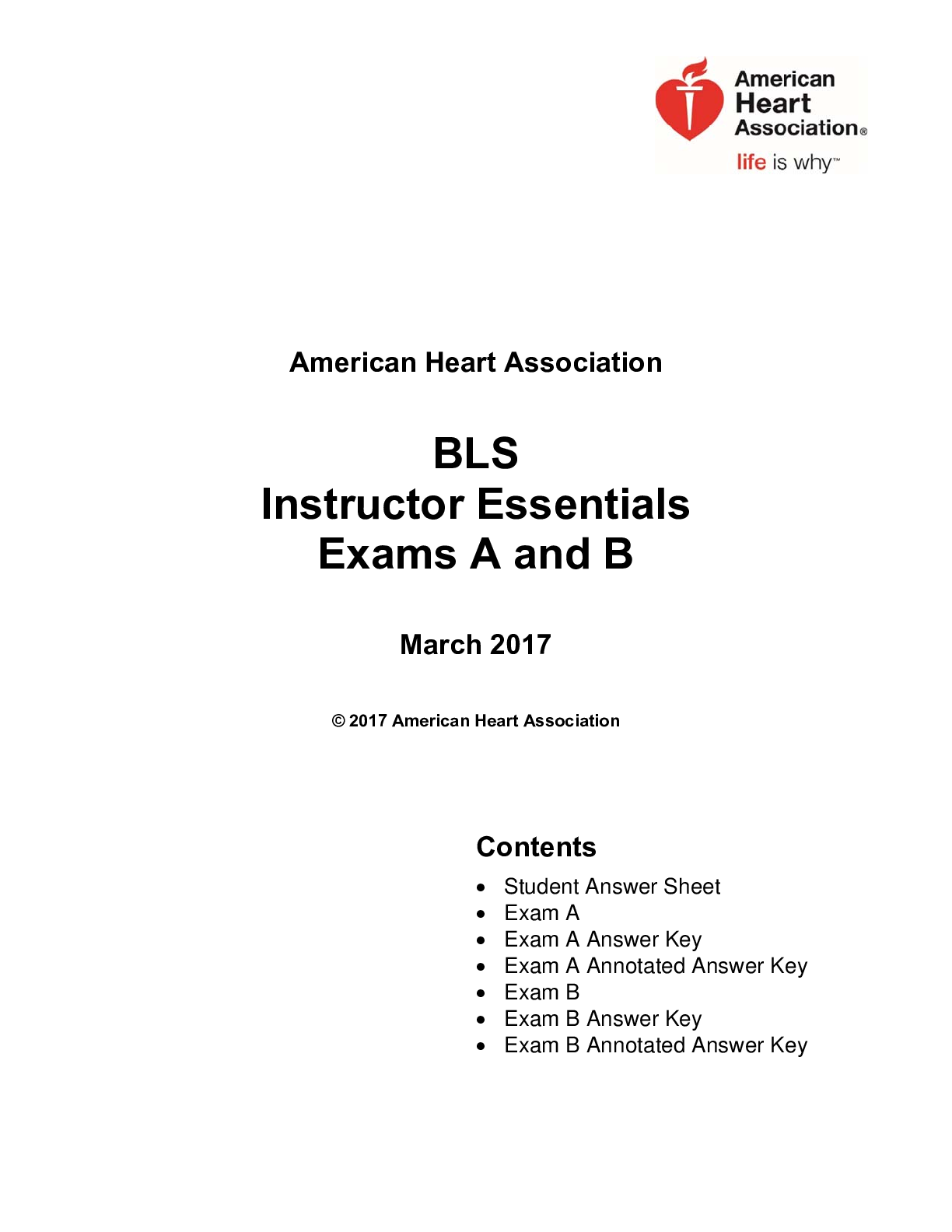
.png)
.png)
